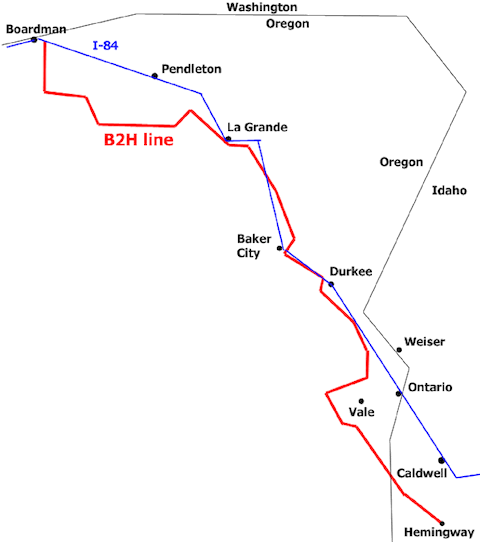forum
library
tutorial
contact

Judge Rejects Challenge to
Eastern Oregon Transmission Line
by Mateusz Perkowski
Blue Mountain Eagle, August 6, 2021
|
the film forum library tutorial contact |

|
Judge Rejects Challenge to
by Mateusz Perkowski
|
 A federal judge has rejected arguments by opponents of a 300-mile transmission line in Eastern Oregon who sought to stop the project for allegedly violating environmental laws.
A federal judge has rejected arguments by opponents of a 300-mile transmission line in Eastern Oregon who sought to stop the project for allegedly violating environmental laws.
U.S. District Judge Michael Simon has determined the U.S. Bureau of Land Management approved a right-of-way across public land for the project in compliance with the National Environmental Policy Act and Federal Lands Policy Management Act.
The Stop B2H Coalition and other plaintiffs filed a complaint in 2019 claiming the transmission line between Boardman, and the Hemingway substation in Idaho should have been more closely scrutinized for impacts to the greater sage grouse and other factors.
The proposal has also stirred controversy for taking farmland out of production and disrupting agricultural practices, such as aerial pesticide spraying.
The lawsuit argued the BLM should have updated its environmental analysis of the project -- known as a final environmental impact statement or FEIS -- with new information about sage grouse populations, which have plummeted from historic levels.
While studies completed after the project's approval provided new information about population counts and the effects of transmission lines, the judge said they're "not significant or seriously different" enough to warrant a supplementary analysis.
"The new information about the declining population of greater sage grouse is not significantly new or different circumstances from what is discussed in the FEIS," Simon said.
Likewise, news articles about the financial feasibility of burying transmission lines do not trigger the need for a supplementary environmental analysis because they don't "rise to the level of significant information," as would scientific studies, he said.
The judge dismissed claims that BLM relied on improper data about sage grouse numbers and that it was impermissibly vague and confusing in examining the risk of "extirpation" to a local population of the species.
"Although not a model of clarity, the discussion is not indecipherable," he said.
The agency wasn't "arbitrary and capricious" in analyzing the indirect effects on "leks," where sage grouse congregate during mating season, within 3 miles of the transmission line, rather than using a longer distance, Simon said.
The judge found that BLM's steps for mitigating the adverse impacts to the species were sufficient because "there can be no construction without a detailed plan."
"This is not a case in which the action will commence before it can be determined whether mitigation will be effective," he said.
The judge said BLM "worked closely" with the Idaho Power utility company on the project and relied on "sufficient evidence" to decide against burying the line near an interpretive center for the Oregon Trail.
The agency wasn't required to update the FEIS regarding the environmental effects of alternative routes for the transmission line that it ultimately didn't choose, he said.
While the BLM wrongly failed to "consider grazing in the cumulative effects analysis" of the project, that "error was harmless" because it wouldn't have altered the agency's conclusions, the judge said.
"Plaintiffs do not show how adding grazing to the cumulative effects analysis would have materially affected the substance of BLM's sage grouse mitigation decision or other decisions relating to sage grouse," Simon said.
learn more on topics covered in the film
see the video
read the script
learn the songs
discussion forum
